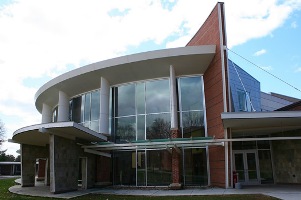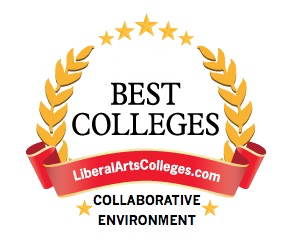
Photo: Skidmore College. Retrieved from: unknown source.
Skidmore College is a private liberal arts college where students can pursue a bachelor of science degree and a bachelor of arts degree. Students can choose up to more than 60 areas of study. A Bachelor of Science degree is awarded to those taking up Art (Studio), Dance, Dance-Theater, Education, Exercise Science, Business, Social Work, and Theater.
Skidmore attracts students who are passionate about art, theater and music. Several facilities in Skidmore attract young artists that want to explore their creative minds in a venue where successful artists have already launched their careers, like the The Frances Young Tang Teaching Museum and Art Gallery, which is located in the campus and opened in 2000. The museum, which is considered an architectural masterpiece, is equipped with digital facilities and spacious event areas. Extensive art collections are kept in the museum and serve the school by attracting art patrons and collectors, as well as keeping the students inspired.
Skidmore students use some of the galleries for their classes, and exhibits are frequent events in the halls. Besides visual arts exhibitions, the museum also plays host to plays, musicals and dance recitals. Other structures related to the arts are the Arthur Zankel Music Center and the Janet Kinghorn Bernhard Theater.
School History
Skidmore College was originally The Young Women’s Industrial Club, which was established by Lucy Ann Skidmore in 1903. Lucy Ann was a rich widow who invested her late husband’s and her late father’s money into an institution. Her father was a coal merchant. In 1911, a charter was awarded to the club and the name was changed to Skidmore School of Arts. This college was meant to teach vocational courses and train women for professional work. The college’s goal at that time was to produce designers, dieticians, accountants, secretaries, costumers and illustrators.
In 1922, the institution had been independently chartered as a four-year college where degrees are granted to deserving students. Skidmore College’s first location was downtown Saratoga Springs, but the campus was transferred to the Jonsson Campus in the later part of 1961. The campus’ namesake was Erik Jonsson, the founder and president of Texas Instruments. Jonsson was also the mayor of Dallas, Texas from 1964 to 1971.
Men began attending classes in Skidmore in 1971. Several men were veterans of World War and enrolled right after the war. Skidmore started a program that accepts non-resident students over 25 years of age into the college, but this program was closed in 2011. There is a chapter of the honor society Phi Beta Kappa in Skidmore.
Since 1988, students and Skidmore faculty can join the Collaborative Research Program, which gives students a chance to become co-authors with their faculty mentors in reports and journals. The first masteral program in Skidmore was Master of Arts in Liberal Studies (MALS). The Honors Forum was established at Skidmore in 1998.
Campus Life
Students will enjoy the social life and the general vibe at Skidmore. Creating a social life involves joining clubs that have an active membership. Students that prefer smaller group dynamics to big parties will find niches where they can find good companions, whether the club is about academics or athletics.
Students can also go to nearby Saratoga Springs regularly, which is within hiking distance or a bus-ride away. The town is packed with students on weekends, especially the restaurants and coffee shops. Skidmore has a great art community and any aspiring artist will find the moral support and inspiration he or she needs just by attending class in the college.
Financial Aid
The Office of Financial Aid Services takes care of assigning packages for students with demonstrated financial need, as well as those that are qualified to receive merit scholarships. A typical financial aid package comprises a grant, a campus job, and a loan option. The average debt after graduation is $20,000.
Rankings
2017 College Rankings



